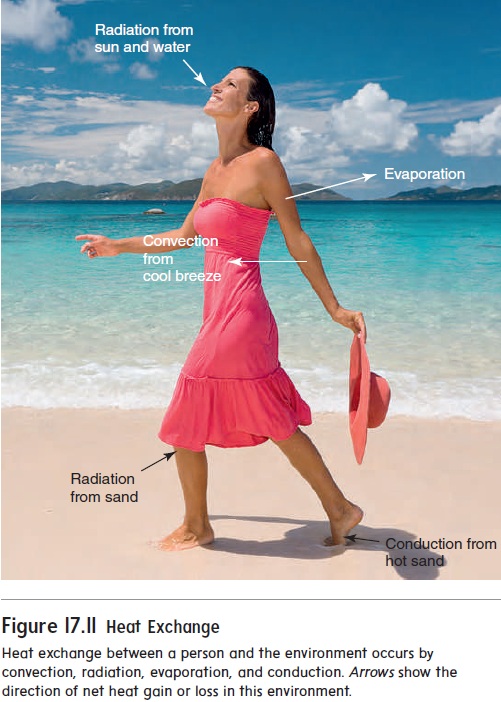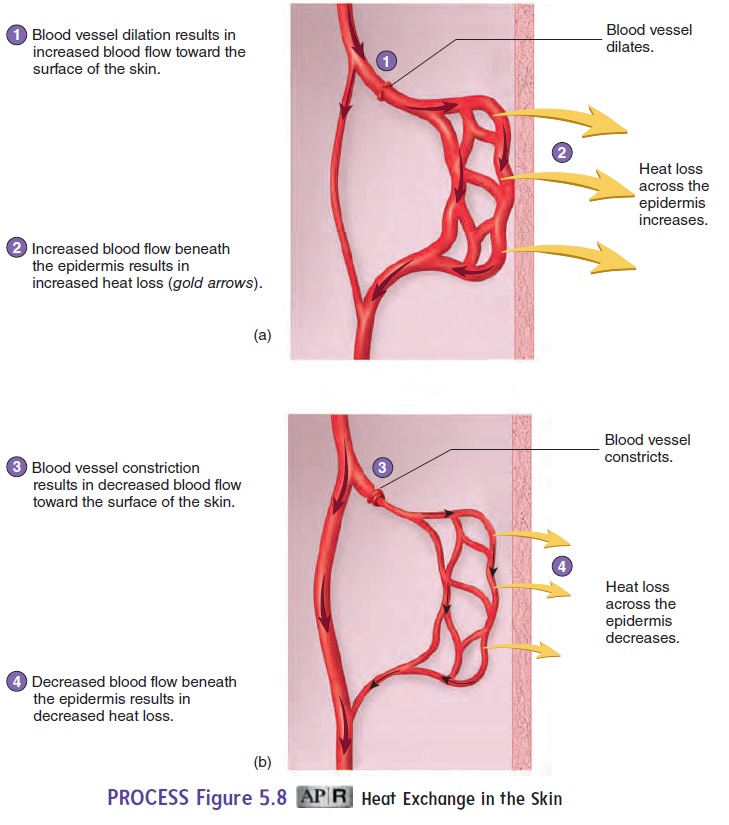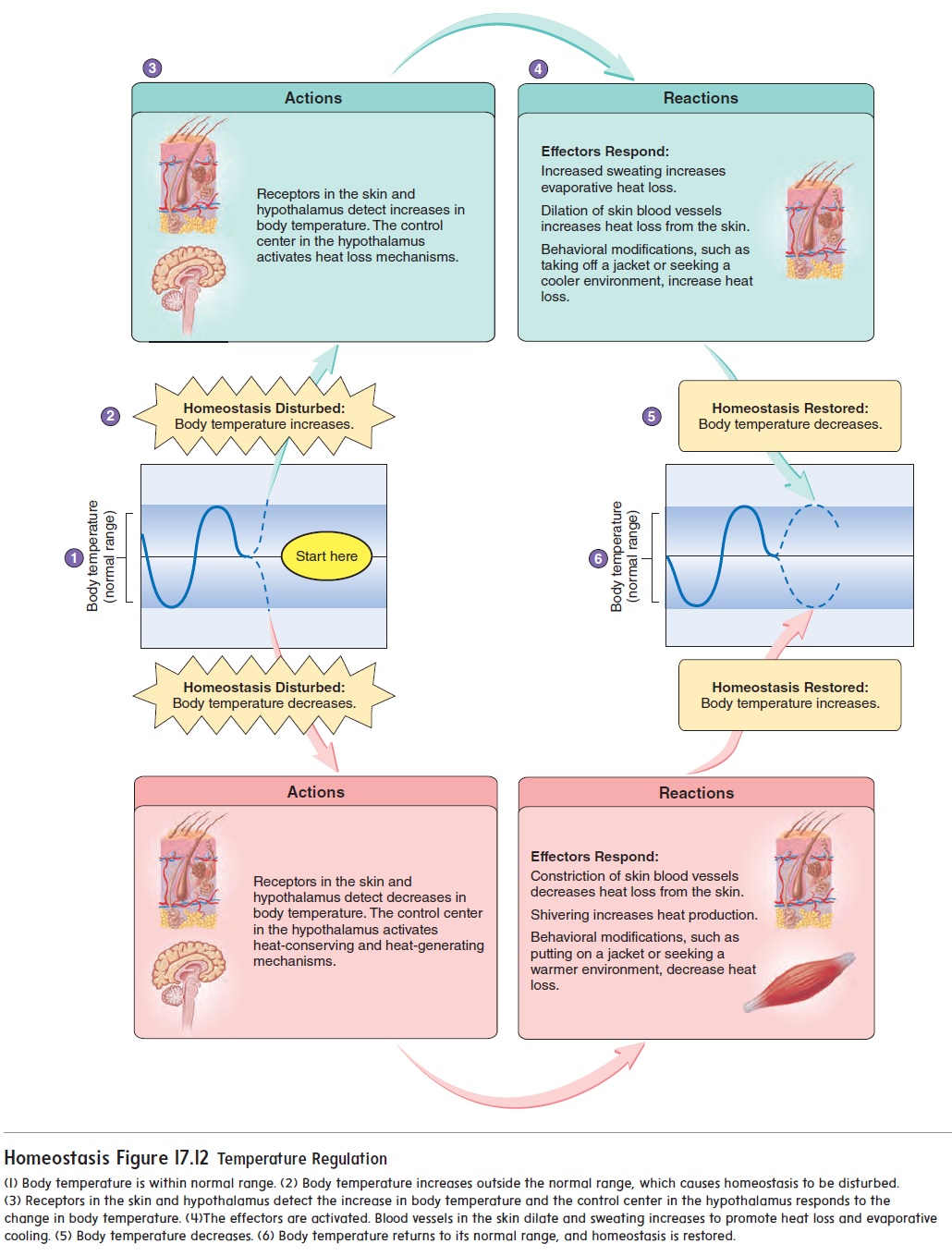Chapter: Essentials of Anatomy and Physiology: Nutrition, Metabolism, and body Temperature Regulation
Body Temperature Regulation
BODY TEMPERATURE REGULATION
Humans can maintain a relatively constant internal body temperature despite changes in the temperature of the surrounding environ-ment. A constant body temperature is very important to homeo-stasis. For example, environmental temperatures are too low for normal enzyme function. The heat produced by metabolism and muscle contraction helps maintain the body temperature at a steady, elevated level that is high enough for normal enzyme function. Excessively high temperatures can alter enzyme structure, resulting in loss of the enzyme’s function.
Free energy is the total amount of energy that can be liber-ated by the complete catabolism of food. About 40% of the total energy released by catabolism is used to accomplish biological work, such as anabolism, muscular contraction, and other cellular activities. The remaining energy is lost as heat.
Normal body temperature is regulated in the same way as other homeostatic conditions in the body. The average normal temperature is usually considered to be 37°C (98.6°F) when mea-sured orally and 37.6°C (99.7°F) when measured rectally. Rectal temperature comes closer to the true core body temperature, but an oral temperature is more easily obtained in older children and adults and therefore is the preferred measure. The normal oral temperature may vary from person to person, with a range of approximately 36.1–37.2°C (97–99°F).

Body temperature is maintained by balancing heat input with heat loss. The body and the environment exchange heat in a num-ber of ways (figure 17.11). Radiation is the gain or loss of heat as infrared energy between two objects that are not in physical con-tact with each other. For example, heat can be gained by radiation from the sun, a hot coal, or the hot sand of a beach. On the other hand, heat can be lost as radiation to cool vegetation, water in the ocean, or snow on the ground. Conduction is the exchange of heat between objects that are in direct contact with each other, such as the bottom of the feet and the ground. Convection is a trans-fer of heat between the body and the air or water. A cool breeze moves air over the body and causes loss of heat from the body. Evaporation is the conversion of water from a liquid to a gaseousform. As water evaporates from body surfaces, heat is lost.
The amount of heat exchanged between the environment and the body is determined by the difference in temperature between the two. The greater the temperature difference, the greater the rate of heat exchange. Control of the temperature difference can be used to regulate body temperature. For example, if the environmental
temperature is very cold, as occurs on a winter day, there is a large temperature difference between the body and the environment, and therefore a large loss of heat. Behaviorally, we can reduce the loss of heat by selecting a warmer environment, such as by going inside a heated house or by putting on extra clothes. Physiologically, the body controls the temperature difference through dilation and constriction of blood vessels in the skin. When the blood vessels dilate, they bring warm blood to the surface of the body, raising skin temperature; when the blood vessels constrict, blood flow and skin temperature decrease (see figure 5.8).

When environmental temperature is greater than body tempera-ture, dilation of blood vessels in the skin brings blood to the skin, causing an increase in skin temperature that decreases the gain of heat from the environment. At the same time, evaporation carries away excess heat to prevent heat gain and overheating.
Body temperature regulation is an example of a negative-feedback system (figure 17.12). Maintenance of a specific body temperature is accomplished by neurons in the hypothalamus, which regulate body temperature around a set point. A small area in the anterior part of the hypothalamus can detect slight increases in body temperature through changes in blood temperature. As a

result, mechanisms that cause heat loss, such as dilation of blood vessels in the skin and sweating, are activated, and body tempera-ture decreases. A small area in the posterior hypothalamus can detect slight decreases in body temperature and can initiate heat gain by increasing muscular activity (shivering) and by initiating constriction of blood vessels in the skin.
Under some conditions, the hypothalamus set point is actu-ally changed. For example, during a fever, the set point is raised. Heat-conserving and heat-producing mechanisms are stimulated, and body temperature increases. To recover from a fever, the set point is reduced to normal, heat loss mechanisms are initiated, and body temperature decreases.
Related Topics